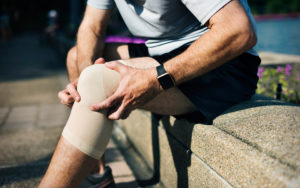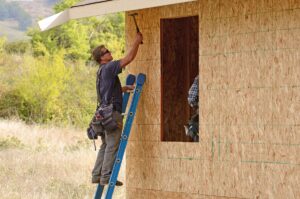Knee pain is something that many of us experience (over a quarter of us, to be exact)… but for some reason, many people don’t know that there are knee pain treatment methods besides surgery and intense pain killers.
Surgery and pain medications have their place in knee pain relief, sure. But there are many other methods that you can use to strengthen your muscles, increase your mobility, reduce pain, and correct any compensatory movements you’ve made to continue your daily activities.
In my years of physical therapy work, I’ve seen people develop limps, change their walking gait, and even stop participating in activities they love in order to find some knee pain relief. Instead of changing how you exist, giving up on things you love, and going straight for an invasive & intense surgery, I recommend trying other knee pain treatments.
You’ll be amazed at what some hard work and dedication to a physical therapy & rehabilitation program can do to reduce knee pain and improve your knee function. No matter what the cause of your knee pain is, there are paths to relief.
Let’s look at a few knee pain treatment options that can change your life if you let them.
Diet & Lifestyle Adjustments
Diet and lifestyle are two of the most important factors for proper treatment of knee pain, but are perhaps some of the hardest things to change.
It’s hard to admit that some of your favorite foods, some of your guilty pleasures, or some of the ways that you live your life could be contributing to your pain. Not to mention, then giving them up! However, making some simple changes to your lifestyle can have huge effects on your pain levels and your mobility in the knee.
Weight & Nutrition
Knee pain is one condition that’s most affected by a patient’s weight. More than other types of pain, obesity is strongly correlated to a higher risk of developing knee pain.
Think about it like this. If you’re overweight or obese, your knees have to bear a lot more weight than they would if you were at a lower weight. This excess pressure and weight on the knees leads to increased risks of arthritis, osteoarthritis, and general knee pain with the risk increasing as the weight does.
With over 42 percent of adults in the United States considered to be overweight or obese, it’s no wonder that knee pain and injury in the US has significantly increased in recent years.
The silver lining here is that weight loss can be a holistic treatment option to provide knee pain relief. While weight loss won’t cure your issues or reverse damage, it can and will take pressure and weight off of the knees, reducing pain. Weight loss can also improve your mobility, making it easier to perform treatment exercises.
Lifestyle Changes
Knee pain can make it hard to get out of bed, let alone get exercise.
But exercise is one of the best ways to improve your body’s ability to heal. Staying sedentary for too long or neglecting to move around as a way to avoid knee pain can actually worsen your condition. Failing to exercise can lead to the weakening of the knee and the muscles & connective tissues around and in it. This, you guessed it, can worsen your condition and make it more difficult to heal over time.
Exercise can also help loosen up any stiffness you have and work to help you lose weight, which can reduce your pain. Exercise can also improve the circulation in your blood to better distribute nutrients throughout your body, speeding up the healing process.
Pain Medications
We understand that many people aren’t fans of taking pain medications. This could be for a number of reasons: negative side effects, expense, the “tough people” that “don’t need them,” the fear of getting addicted… the list goes on. Obviously, if you feel as though any of these — particularly addiction — is a realistic possibility, ensure to consult your doctor.
But if you’ve been instructed by your doctor or by another medical professional to take your medications, you should do so. Instead of simply taking the pain medication and acting like it’s a cure, use the medication as a tool.
This tool will make physical therapy & rehabilitation more bearable and will help you take other steps and treatment options to heal your knee pain.
Knee pain bothering you? Fed up with your reliance on medication?
Sign up for our FREE August 8th workshop that addresses common questions — and answers — about knee pain.
Professional Modalities & Techniques
Now, let’s look at some professional modalities & techniques that medical professionals like the ones here at MOSS use as part of a knee pain treatment plan.
Exercises & Stretches
Exercises and stretches outlined by medical professionals are designed to strengthen the muscles and connective tissue in the problem area. This works to reduce pain, improve your mobility, and generally strengthen the area to prevent future injuries or to prepare for surgery (more on this later).
Unlike some other medical professionals, our MOSS physical therapists work with every patient to learn about their specific symptoms, injuries, conditions, and knee pain. We don’t work off of templates or pre-made plans.
We’ll outline specific exercises and stretches tailored to your condition, injury, and wellness goals.
Massage
Massage can stimulate blood flow, reduce stiffness, and help with pain relief. We can also use manual therapy and massage to evaluate your condition, make a more targeted diagnosis, and prepare a more personalized treatment plan.
Deep Tissue Laser
The words “deep tissue laser” might sound scary and intimidating, but don’t worry. It’s actually not painful and it can greatly decrease many types of pain, including knee pain!
Here’s how it works. State of the art technology uses a concentrated and powerful beam of light (aka a laser) that can penetrate through to the deepest layers of your muscles. Ranging in power from 0.5 Watts up to 25 Watts, deep tissue laser treatments can be used on a variety of pain levels, injuries, and conditions.
The light energy triggers your cellular metabolism to reduce inflammation at the source. This, in turn, reduces pain and stiffness in areas that couldn’t be reached with manual therapy & massage.
Dry Needling
Dry needling is a technique used to target specific areas in a patient’s muscles that are tender, sore, or knotted.
Knee pain can vary from general soreness to specific areas of pain, so this modality’s effectiveness will greatly depend on your particular condition and/or injury.
Similar to acupuncture, dry needling involves putting small & fine needles into problem areas in the muscle. This could be stiffness, pain, tenderness, or muscle knots.
Inserting these needles into those areas triggers the release of healing and pain-relieving chemicals in that area.
Electrical Stimulation
Electrical Stimulation (ES) has a number of peer-reviewed studies backing up its effectiveness for knee pain relief and treatment, especially for those with arthritis or osteoarthritis.
This treatment uses electrodes that stick to the skin around the knee (or wherever your pain is centralized) to deliver electrical stimulation to the muscles and tissues. Like deep tissue laser treatments, ES can use a wide range of frequencies and intensities depending on the severity of the pain & injury.
This stimulation causes the muscles to contract and relax, which can help to increase blood flow and healing in the area. This can also help reduce pain & inflammations while improving mobility.
Ultrasound
Therapeutic ultrasound treatments are similar to Electrical Stimulation and Deep Tissue Laser in that it uses energy to penetrate your muscles and improve blood flow, reduce pain, and stimulate the muscles.
The difference is that instead of using electric energy or light energy, therapeutic ultrasound treatment uses sound waves and the vibrations they create to stimulate blood flow and relieve pain.
Surgical Options
Surgery is an option for many people, and it can be a key part of many people’s recovery.
However, surgery isn’t a cure. In fact, surgery itself is considered an injury: something is cutting into and irritating the muscles and tissues in the knee.
As a result, many people find that post-op their condition feels worse. Or, they find that they still have pain or discomfort and think the surgery was a failure.
The true failure is a management of expectations. Surgery isn’t a cure: you will need to put in effort to strengthen and rehabilitate the knee both before and after your surgical procedure.
Knee Pain Treatments: Get Relief with MOSS
Each of these knee pain treatment options are available here at our office. At MOSS, we believe in customized treatment plans to align with each individual patient’s conditions, pain & comfort levels, and wellness goals.
Our professionals work to create a treatment plan made specifically for you. Long-term knee pain relief isn’t easy, but MOSS can help make it a bit easier.
Contact us to set up an appointment and to learn more about potential treatment options for you. Get started on your personal healing journey today!
And if you’re experiencing knee pain currently, consider one of two options — or both. First off, give us a call for a FREE discovery visit with us. And second, sign up for our FREE August 8th workshop specifically on knee pain. We’ll answer the most popular questions related to knee pain, knee pain treatment, and take any questions you might have.


